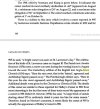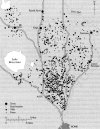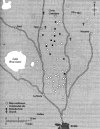Of all the things written by Procopius in SECRET HISTORY, quoted above, the following short extract encapsulates the point I would like to make in this brief section:
That Justinian was not a man, but a demon, as I have said, in human form, one might prove by considering the enormity of the evils he brought upon mankind. For in the monstrousness of his actions the power of a fiend is manifest.
Such were the things done to all mankind by the demon in flesh for which Justinian, as Emperor, was responsible. But what evils he wrought against men by some hidden power and diabolic force I shall now relate.
In these two sentence, Procopius separates the actions of Justinian, the “demon in flesh” from those things that he could not possibly have done himself, as a man of flesh, but which Procopius is suggesting were due to some “hidden power, diabolical force” that somehow, gained access to the world by virtue of the fact that Justinian was the ruler - or due to Christianity itself. The next sentence makes this absolutely clear:
During his rule over the Romans, many disasters of various kinds occurred: which some said were due to the presence and artifices of the Devil, and others considered were effected by the Divinity, Who, disgusted with the Roman Empire, had turned away from it and given the country up to the Old One….
To make sure that there is no misunderstanding, Procopius gives examples of what he means:
… Antioch… Seleucia… Anazarbus… Ibora… Amasea…Polybotus…Lychnidus …Corinth… All of these were destroyed by earthquakes during this time, with a loss of almost all their inhabitants. And then came the plague, which I have previously mentioned, killing half at least of those who had survived the earthquakes. To so many men came their doom, when Justinian first came to direct the Roman state and later possessed the throne of autocracy.
Procopius is saying explicitly that the earth and its people suffered BECAUSE Justinian was in power and not just because of the things he did directly to harm others. Did Procopius actually believe this or was he, as has been suggested, just turning the Christianity of Justinian back on itself?
It is true that in all his other writings he is supremely rational and doesn’t appear to be overly religious in any way either inclined toward Christianity or Paganism. What is also true is that he used the ancient pagan models of literature freely; he wrote THE WARS in the style of Herodotus and Thucydides.
Was he making his book an “imitation” of classical histories as a means of conveying a message? It’s possible. Procopius also mixes some statements of apparent Christian piety with obviously pagan reflections on fortune. That tends to be confusing. However, he did write in Chapter 11 of SECRET HISTORY:
A similar law was then passed against the Samaritans, which threw Palestine into an indescribable turmoil. Those, indeed, who lived in my own Caesarea and in the other cities, deciding it silly to suffer harsh treatment over a ridiculous trifle of dogma, took the name of Christians in exchange for the one they had borne before, by which precaution they were able to avoid the perils of the new law.
Here he is describing himself, as a native of Caesarea and implying that he took the name of "Christian" to avoid the perils of the law. So, did he believe one way or another? I don’t think we can answer that question definitively, but we can say with some confidence, based on his accurate descriptions of certain psychopathologies, that Procopius was so completely baffled by what he saw in Justinian and in the world around him that it may have almost “made a believer” out of him, but a believer in the idea that Christianity was an overpowering evil. This is not an uncommon reaction to individuals who are forced by some situation, to really observe and consider the behavior of the personality disordered; it can really make you think that the only explanation for such behavior is that it is demonic possession! Having taken that step, it isn’t far to go to engage in some nonsensical religious belief system that purports to account for “demons”. Since the gods and goddesses of the pagans had both benevolent and destructive characteristics, it wasn’t necessary to designate any single force as “demonic”. Yet, what Procopius recorded about the disasters that came during the reign of Justinian we again face that explicit remark:
…some {Christians} said were due to the presence and artifices of the Devil, and others {Pagans} considered were effected by the Divinity, Who, disgusted with the Roman Empire, had turned away from it and given the country up to the Old One {the evil god of the Christians}…
That is a Christian oriented statement: “The Divinity” and “The Old One.” As has been said, this seems to support the idea that Procopius was turning Justinian’s Christianity back on him, he wasn’t falling into a belief in demons. But still, it is obvious that Procopius was troubled by the apparent synchronicity of the rule of so bizarre an individual as Justinian with the climatic, geological, and atmospheric phenomena of the time.
...
Justinian, had his mind made up from the beginning and followed a single-minded plan to stamp out anything that did not conform to what HE had determined to be the right way, the ONLY way. And when things continued to deteriorate, instead of questioning himself at all, he saw it as some hidden fault of the people that he was going to root out and destroy. This, I believe, is the element that was so poisonous to human society and even, I venture to suggest, to the planet itself. When an individual such as Justinian rises to power, it is not that unusual: pathology always seeks power over others. But when such an individual is not overthrown, it seems to be evidence of a pathological state spreading throughout the body social and politic much as a cancer takes hold in a weakened human body, invading, spreading, and destroying what is normal. Kaldellis writes:
History seemed to accelerate during Justinian’s reign, and many believed that the result was chaos and upheaval. Few emperors had started so many wars or tried to enforce cultural and religious uniformity with such zeal. There had been despots before, but few, or none, had made despotism a matter of legal principle. This is important, for Justinian was anything but unprincipled. Few rulers had ever been as eager to provide ideological justification for their policies. In his edicts Justinian buttressed everything from his wars to the regulation of the price of vegetables with divine authority. He was constantly musing about how his reign fit into God’s plan and expected total ideological conformity from all writers linked to the court. In the words of one legal historian, Justinian was “conscious of living in the age of Justinian.” […]
The SECRET HISTORY, finished around 551 but never published by its author, who feared for his life, contains a vicious attack on Justinian and every aspect of his regime. Its tendency to exaggerate rhetorically cannot be denied, but its basis in fact has not been successfully impugned. The SECRET HISTORY shatters the façade of consensus and benevolence presented by Justinian and his spokesmen by confirming the worst that cynics can imagine about the motives and behavior of emperors and their officials.
Did Procopius suggest any solutions or remedies for such a tyrant as Justinian? Anthony Kaldellis believes that he did and that the hidden messages are incorporated into the text of THE WARS: there is only one way to deal with a tyrant: assassination. He points out that one of the ways to discuss conspiracies against tyrannical regimes during times when the regime itself does not tolerate criticism, is to discuss past conspiracies in general, historical terms, including why they failed or succeeded. Such a discussion of past conspiracies can be a disguised manual for future ones. Since such accounts of assassination conspiracies take up a lot of the text of THE WARS, and are described in greater detail than any other kind of event, Kaldellis suggests that this communicates the subtext of what Procopius was saying to certain of his readers: those who “understood the message by way of the many classical allusions.” If that is the case – and Kaldellis makes a solid argument for it – then it means that Procopius was deliberately writing in code from the beginning and this gives us a whole different perspective on the works of Procopius.
....
Paying close attention to the descriptions of natural disasters that Procopius lists at the end of SECRET HISTORY where is made the suggestion that God was disgusted with the reign of Justinian, we notice the short list of cities said to have been totally destroyed during that 38 year reign:
… Antioch… Seleucia… Anazarbus… Ibora… Amasea…Polybotus…Lychnidus …Corinth…
… and then says:
All of these were destroyed by earthquakes during this time, with a loss of almost all their inhabitants. And then came the plague…
We have already looked at the work of NASA’s John Lewis who thinks that the Great Antioch Earthquake was actually an overhead cometary explosion based on the descriptions. If that was the case, the grouping of these particular “earthquakes” together might mean that they were all of the same type: overhead cometary explosions of the extremely destructive Tunguska kind.
Ward-Perkins notes that “bubonic plague” reached the Mediterranean “from Egypt” in 541 during the reign of Justinian and spread through the Roman world. He sees this as playing only a subsidiary role. It was, according to him, a “personal tragedy” for many people, and something of a demographic blow, but still, not one of the major reasons Rome ceased to exist.
I think he has completely underestimated what was really going on. As he discusses extensively himself, at a certain point in time, material sophistication disappeared from the Western Roman Empire. The middle and lower markets (that is, the people who were the consumers), almost entirely disappeared. All sophistication in the production and trade of pottery disappeared from the whole of Britain and large areas of coastal Spain. Pottery was no longer being made on wheels, and there was nothing aesthetic about what little was being produced during this time. It is as though all the skilled potters just packed up and left – or they all died.
In the north of Italy, some wheel-turned pots continued to be made for awhile, but decorated tableware almost entirely disappeared (one suspects that any finds were of previously made items that continued in use for awhile) and the range of items reduced to only a few basic shapes. By the 7th century, the only vessel being used in northern Italy was a primitive, roundish cooking pot.
Interestingly, this collapse was not total everywhere; some pockets survived for a time. There were factories in North Africa that continued to make and export (to some extent), tableware throughout the 5th, 6th, and into the 7th centuries, but the number of items exported, and their distribution range shrank dramatically as though there was no one to buy their wares. Only a few sites on the coasts and Rome, itself, continued to use such items which may indicate that these were pockets of survival with death all around. Rome continued to import amphorae and medieval glazed wares were developed there, but it is clear that Rome was something of an island of survival. Moreover, even the quantities produced for the Roman population significantly declined probably because the population itself declined. Based on current evidence, during the 6th and 7th centuries, good quality products were only available to the elite and what had once been widely diffused amongst the entirety of the population, had become luxury items. The lands north of Rome itself, reveal this fact in the lack of any significant finds dating to those times.
Some regional potters in a few scattered areas continued to produce wares on the continent, such as in southern Italy and the Rhineland. But these were not high-quality products; in fact, the decline in quality is said to be startling. And, once again, the middle and lower markets (determined by the character of where remains are found), had wholly disappeared. More disturbing than even the decline in quality and variety of goods is the evidence that quantity fell drastically. That is to say, the numbers of consumers obviously were no longer there.
Every one of the building crafts that the Romans had introduced into Britain disappeared completely in the 5th century. There is no evidence for any quarrying continuing, no manufacturing of tiles or bricks, and any new buildings of that period are primitive, made of wood, roofed with thatch. It wasn’t until the end of the 7th century that a peripatetic abbot introduced builders from Gaul so as to be able to build churches “in the Roman manner”. Glaziers were described as “crastmen as yet unknown in Britain.” The surviving structures that were built as a result of this enterprise were small and primitive by earlier Roman standards. This was, essentially, the reintroduction of building skills that had disappeared from Britain for almost three hundred years!
The decline in building technology was not as drastic in the Mediterranean region, though indeed, the drastic reduction in quantity was again evident. And again, domestic structures were built of perishable material, as though the technical know-how to build things from brick or stone had been lost. Stone and brick houses with tile roofs and drains, underfloor heating, mosaic floors, disappeared and wooden huts with thatched roofs replaced them. Even the elite suffered this reduction in style and quality of residences. Archaeologists have tried, but failed, to find any continuity of the impressive architecture that was a feature of the Roman period. It just stopped happening all over the Western Empire.
A greatly limited continuation of stone/brick and mortar construction did survive in Italy and a few other places, and appears to have been used only for churches, but the size and ambition of these projects was miniscule compared to the still standing buildings of the period of Empire. Furthermore, as far as the archaeologists can tell, this work was based on used bricks and stones scavenged from already-existing structures; none of it was newly quarried or fired. It was almost a thousand years before roof tiles again became as widely available as they had been in Roman times. Early medieval floors were no longer the stone and tiles of the Romans, but basically just pounded dirt.
Another item that disappeared was coinage. Coins were widely used for commercial transactions in the days of the Empire and many have been found in archaeological digs up through the 4th century. By the beginning of the 5th century, coins reaching Britain was were rare events. In the Mediterranean, this cessation of making and using coins was a bit less sudden and less total, but it was still evident and profound. Bryan Ward-Perkins comments on the evidence as follows:
What we observe at the end of the Roman world is not a ‘recession’ or – to use a term that has recently been suggested – an ‘abatement’, with an essentially similar economy continuing to work at a reduced pace. Instead what we see is a remarkable qualitative change, with the disappearance of entire industries and commercial networks. The economy of the post-Roman West is not that of the fourth century reduced in scale, but a very different and far less sophisticated entity.
This is at its starkest and most obvious in Britain. A number of basic skills disappeared entirely during the fifth century, to be reintroduced only centuries later. … All over Britain the art of making pottery on a wheel disappeared in the early fifth century, and was not reintroduced for almost 300 years.
Ward-Perkins points out that items that were once widespread became rare and precious and only for the elite survivors in Britain as evidenced by the Sutton Hoo burial which contained silver and copper dishes from the eastern Mediterranean, and other treasures, some from the continent and others certainly made in Britan and displaying high levels of craftsmanship. Beautiful things were still being made in tiny numbers and isolated places, traded, gifted, and traveling over long distances, but it was rare or these items were survivals from a former time. A pottery bottle found in the Sutton Hoo burial was, at that time, a high-status item. But in Roman times, the same types of bottles were found even in rural peasant dwellings.
So, let me say it again:
The population that created and sustained a massive and vigorous economy had all but disappeared entirely.


 Going to edit my post.
Going to edit my post. 
